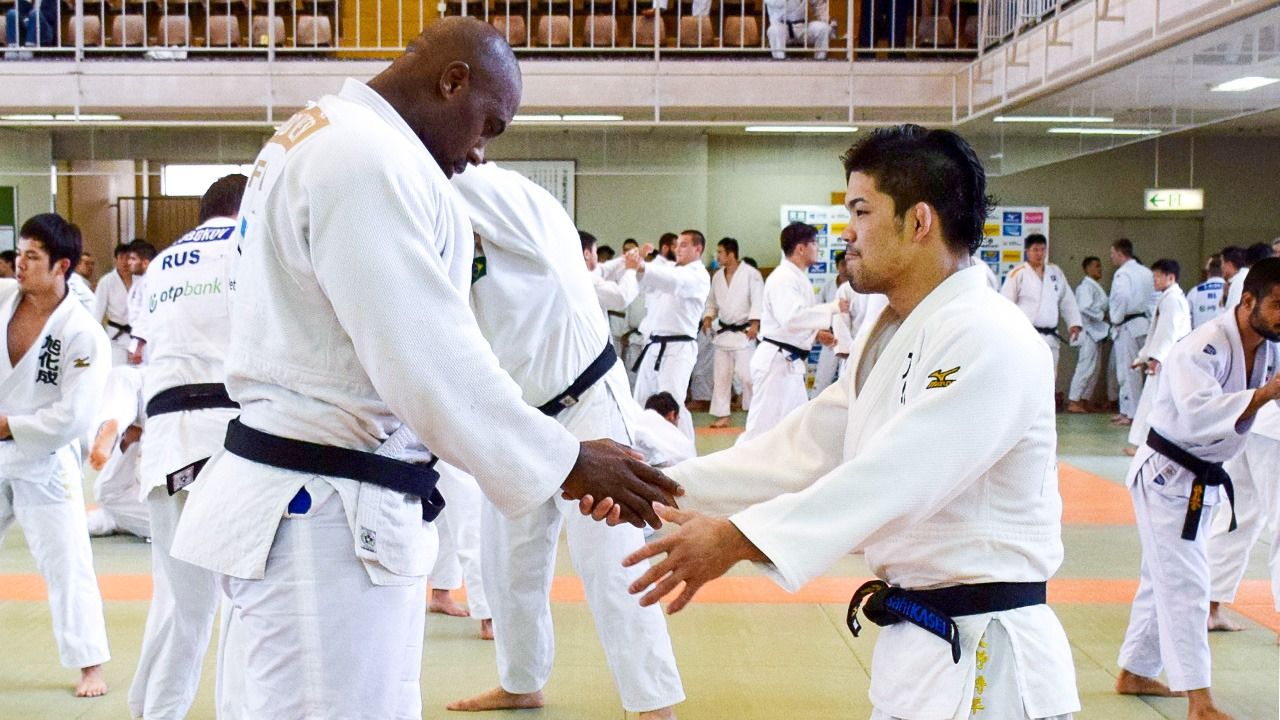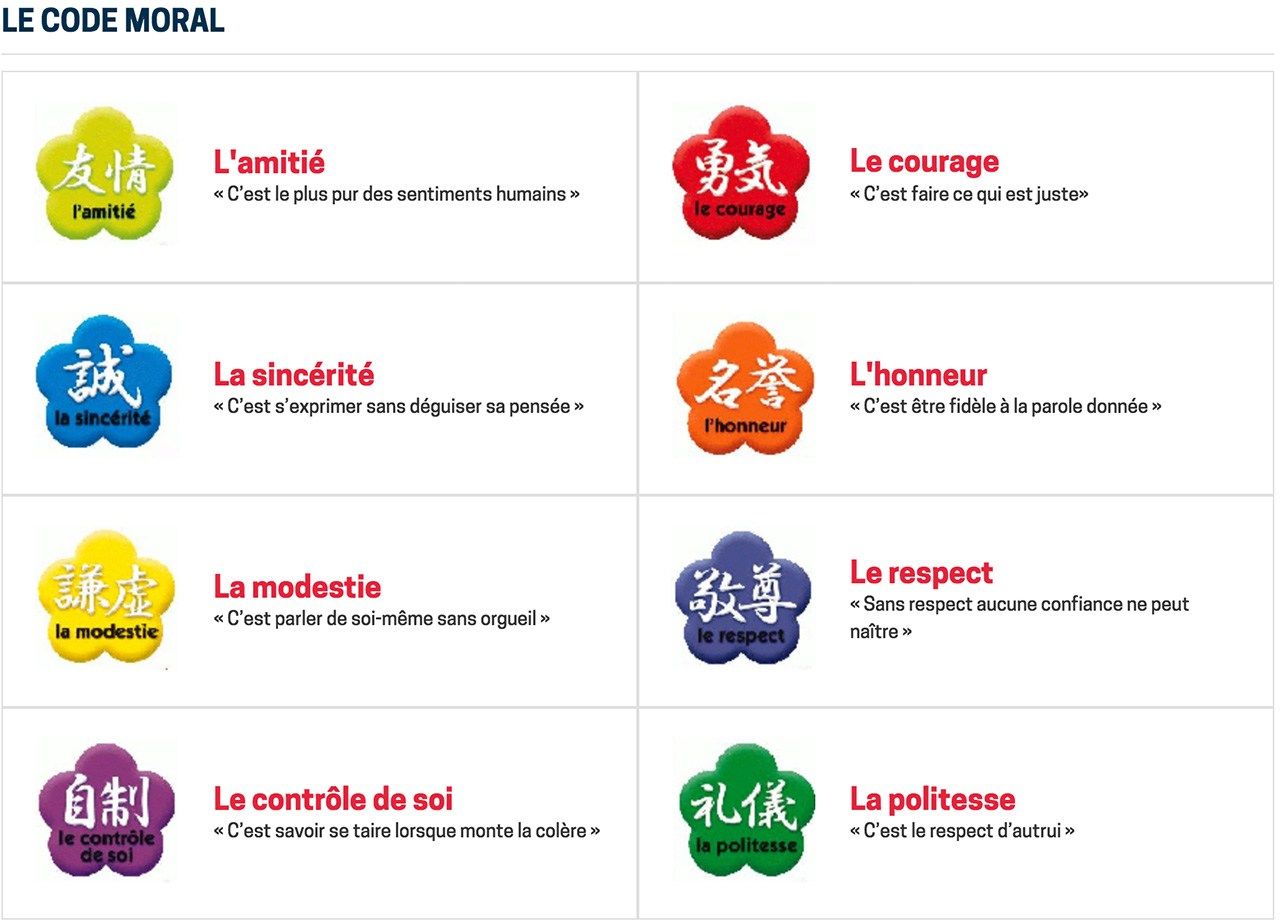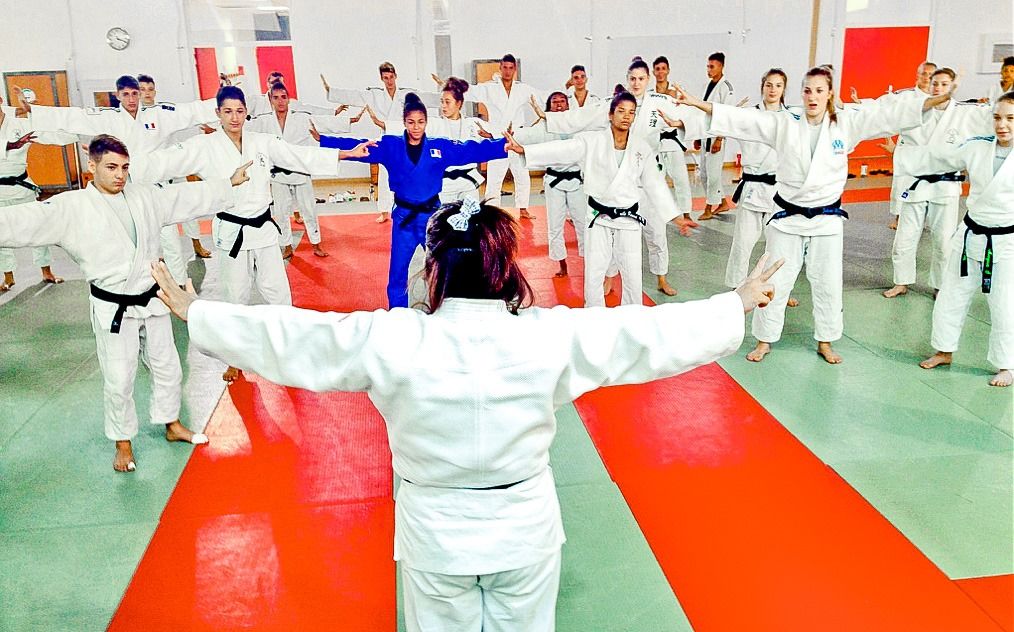
How France Is Keeping the Spirit of Jūdō Alive
Society Sports Culture- English
- 日本語
- 简体字
- 繁體字
- Français
- Español
- العربية
- Русский
In 2017, the French Jūdō Federation had 604,816 registered members(*1), making jūdō the country’s fifth most popular competitive sport after soccer, tennis, basketball, and equestrianism. This number far outstrips the membership of the All-Japan Jūdō Federation, the equivalent organization in jūdō’s home country, which has some 150,000 registered members.
There are 5,700 jūdō clubs in France, and around 75% of members are aged from 10 to 19. For this reason, the federation places a big emphasis on ethics and morality in its training. It uses its own code of conduct with eight precepts that serve as guiding principles for instructors and students alike. Each of these uses a Japanese word written in kanji, suggesting how French jūdō has absorbed the influence of Japanese ideas of morality.

The “moral code” of the French Jūdō Federation, taken from its website. The eight precepts are friendship, courage, sincerity, honor, modesty, respect, self-control, and politeness.
French jūdō has produced several national stars, such as current Olympic champion Teddy Riner, who took gold in the men’s +100kg events at the London and Rio de Janeiro Olympics.
How did jūdō become so popular in France, so far from its country of origin? And how did France come to have more practicing jūdōka than Japan? I want to consider these questions by looking back over the history of modern jūdō.
The Men who Took Jūdō to the World
During the Meiji period (1868–1912), martial arts like jūjutsu and swordsmanship were important survivors of traditional samurai culture in a rapidly modernizing Japan. Perhaps the most important figure in preserving these martial arts for the new age was Kanō Jigorō, who founded modern jūdō and was responsible for its introduction into school curricula throughout Japan. Kanō worked to preserve jūjutsu and other martial arts at a time when they were in serious decline and worked to find them a place in the new culture, thus ensuring they would be passed down to the next generation. In this respect, his ambitions were similar to those of people like Ernest Fenollosa and Okakura Kakuzō, who sought to preserve Japan’s artistic traditions. Kanō entered the literature department at the University of Tokyo in 1877, the same year as Okakura, and later worked in important roles as an educator, including as the principal of Gakushūin and the Tokyo Higher Normal School.
The tendency to regard martial arts and jūjutsu as part of Japan’s bushidō heritage was particularly pronounced in the West at the time. After founding the Kōdōkan Jūdō Institute in 1882, Kanō was given an appointment in the Ministry of Education in 1889 and sent by the government to observe educational conditions in schools and universities in Europe. He spent a year and a half in Europe, and gave jūdō demonstrations whenever he could afford time off from his official responsibilities. Kanō’s disciple Yamashita Yoshitsugu was in the United States from 1903 to 1907, where he introduced jūdō to people in Seattle, Chicago, New York, and Washington. President Theodore Roosevelt also received instruction in Kōdōkan jūdō around this time. Christopher Benfey, an American literary scholar and professor at Mount Holyoke University has written about how Roosevelt was introduced to jūjutsu by William Sturgis Bigelow, the prominent collector of Japanese art, and became so enthusiastic that he had a special dōjō installed in the White House.(*2)
The spread of jūjutsu overseas meant that this aspect of bushidō now took root in other countries like France. At the time, most people overseas made little difference between jūjutsu and jūdō, seeing them as two examples of Japanese martial arts stemming from the bushidō tradition. This is reflected in the official name of the French Jūdō Federation: Fédération française de jūdō, jūjitsu, kendō, et disciplines associées. That the official name continues to give jūjutsu equal billing to this day reflects the history of the sport in France, and its importance at the roots of modern jūdō.
Following these pioneers, the work of popularizing jūjutsu and jūdō in the West was mostly performed by a limited number of Japanese from the privileged classes. In France, these included people like Sugimura Yōtarō, who served as the Japanese ambassador to Italy and France and on the International Olympic Committee; journalist and essayist Ishiguro Keishichi; and painter Foujita Tsuguharu.
Jūdōka also crossed the seas to Europe. In Britain, Tani Yukio of the Fusen-ryū school and Koizumi Gunji of the Tenjin Shinyō-ryū school were important early instructors. Koizumi was particularly influential, setting up the Budokwai in London, which survives today as the oldest martial arts club in Europe. In France, Kawaishi Mikinosuke of the Kōdōkan created his own French style of instruction and became known as the father of French jūdō. Noguchi Kiyoshi also helped to popularize martial arts and related forms of physical therapy in Europe, so that jūdō and similar disciplines were already well established in Europe by the early decades of the twentieth century. These early instructors, and their devotion to popularization over the course of more than a century, helped jūjutsu and jūdō rise from their obscure origins to become examples of an imported culture to flourish and prosper in the foreign soil in Europe.
The Dai-Nippon Butoku Kai
In prewar Japan, jūdō and jūjutsu were dominated by two major organizations: Kanō’s Kōdōkan and the Dai Nippon Butoku Kai (Greater Japan Martial Virtue Society). During my own career, I took the Kōdōkan’s position as rank-granting authority more or less for granted, but while I was coaching in France, I learned that previously, many people in France had received their training and black belt dan ranking not from the Kōdōkan but from the Butoku Kai, whose name has been all but forgotten by most jūdō practitioners in Japan today.
The Butoku Kai was an important organization, with members of the imperial family as official patrons and governors as heads of its local prefectural branches. It was founded in 1895 with Prince Komatsu Akihito as its first honorary president, and the prominent politician and businessman Watanabe Chifuyu as its first chairman. Senior military figures were appointed as directors, together with bureaucrats and ministers from the Home Ministry and leading martial arts practitioners. The aims of the foundation were to promote Japanese martial arts. With overall control over martial arts groups from around the country, the foundation was responsible for martial arts training and the granting of dan rankings. Ten years later, it had become a huge state-run organization with 1,112,414 members registered in 1906, and an influence that reached beyond Japan via its branches in Europe.
At the time, there were numerous different schools of jūjutsu. In 1906, Ōura Kanetake, chairman of the Butoku Kai, suggested to Kanō that he should create kata forms that could be performed by all practitioners regardless of which school they belonged to. In response, a new committee was put together with Kanō at its head, bringing together 20 instructors representing the ten major schools of jūjutsu under the Butoku Kai. Over the course of a week of meetings, the committee came up with forms that everyone could agree on for the first time. The throwing techniques agreed at the time continue today as the officially recognized nagenokata of the Kōdōkan.
A Postwar Exodus of Jūdōka
During the Allied occupation after the war, General Headquarters disbanded the Butoku Kai because of its militaristic associations, and banned national school jūdō organizations. It was left to Kōdōkan to play the leading role in reviving the discipline after the war.
The breakup of Butoku Kai had an effect that went far beyond Japan. The impact was particularly strong in France, and for a while there was confusion and disarray with numerous rival organizations existing, some of them supporting various old jūjutsu schools or the Butoku Kai alongside Kōdōkan-affiliated organizations. The College des Ceintures Noires de France, which granted dan rankings and had been particularly close to the Butoku Kai, was badly affected by these developments, and called out for charismatic Japanese instructors with high ideals and outstanding leadership skills to come and help rebuild the organization.
The timing was right. In Japan, many jūjutsu practitioners had lost their clubs with the breakup of the Butoku Kai and were open to the idea of making a new start overseas. For example, Michigami Haku, who had come up through the Budo Senmon Gakko martial arts school under the auspices of the disbanded organization, was one well-known instructor who traveled abroad. Another jūdō master who went overseas was Awazu Shōdō, who was not himself a member of Butoku Kai but had won consecutive victories at the Meiji Shrine Jūdō Competition during his student years. They traveled to France at the invitation of Kawaishi Mikinosuke.
Michigami, while teaching at dōjōs recognized by the French government, also worked to popularize jūdō in various countries around Europe, Africa, and the Americas, and helped train the Dutch athlete Anton Geesink, who won gold in the open weight class at the Olympics in Tokyo in 1964. Awazu trained the French national team to world-class standard and was awarded the Légion d’honneur award.
Looking Beyond Medals at the Tokyo Olympics
As jūdō has become internationalized, one sometimes hears criticisms to the effect that the event we see at international competitions these days is not “proper jūdō.” These criticisms are normally referring to the type of jūdō that sprang up following its introduction as an Olympic sport event in 1964. This places a greater emphasis on results, and many people feel that it has fallen into the trap of a win-at-all-costs mentality as a result. “Proper” jūdō, by contrast, would be something closer to the traditional martial art discipline that embodies the ideals of the discipline’s founder, Kanō Jigorō. For Kanō, the result of a bout was never the most important thing. He was more interested in the ideals of jūdō. He taught that people should cultivate their physical and mental strength, and use those strengths to work with others to build a better society. These teachings encapsulate Kanō’s ambition to take the lost spirit of bushidō and pass it on to future generations.
Even as much of the world drifts away from Kanō’s original ideals, his teachings still have a profound effect on French jūdō. As seen in the eight-point code of conduct, French jūdō remains imbued with lofty ideals and aims.

The author coaches jūdōka at a training camp for the French national team at a training center in Marseilles in 2016. (Photo courtesy of Mizoguchi Noriko)
In France, no national competitions are run for children below the age of 12. The number of fatal jūdō incidents involving children is zero. Children start their training by grappling on the mats, freeing them from the fear of being thrown. In Japan, by contrast, the desire to expose children to real contests as quickly as possible means that some instructors put competition first and expose children to their first taste of being thrown early on. In 2010, one author criticized Japanese jūdō for routinely placing young children’s safety at risk, claiming that an average of four children lose their lives in jūdō-related accidents every year, with a further ten seriously injured.(*3))
In 2013, 15 women members of the Japanese team were found to have suffered violence and power abuse at the hands of their instructors and coaches. This was followed by scandals involving inappropriate receipts of grant money by the All-Japan Jūdō Federation and incidents of violence in jūdō clubs at prominent universities. These controversies pressed the federation to draw up a plan for urgent restructuring. Now, with just a year to go till the Tokyo Olympics in the summer of 2020, has Japanese jūdō managed to overcome its problem with physical abuse? Will it be able to embody the ideals put forward by Kanō? The Olympics will be held in jūdō’s spiritual homeland, but merely winning medals will not be enough. The spirit and values of Japanese jūdō will also come under the spotlight.
(Originally published in Japanese on June 20, 2019. Banner photo: Ōno Shōhei, silver medalist in the 73 kg category at the Rio de Janeiro Olympics, shakes hands with Teddy Rinel of France, current two-time gold medalist in the +100 kg category, before a practice bout at an international meet on June 14, 2017. © Jiji.)